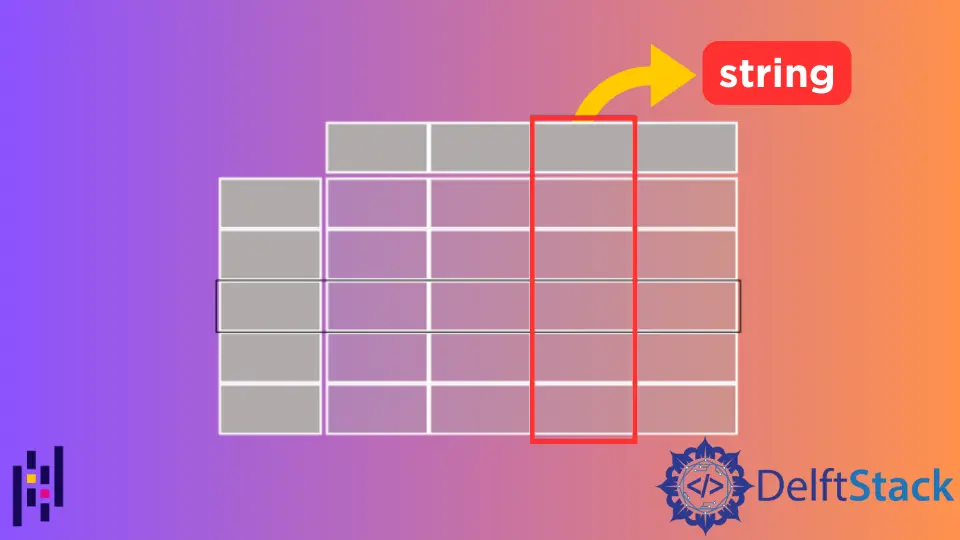Pandas 將列值轉換為字串
Suraj Joshi 2023年1月30日 Pandas Pandas DataFrame Column
- 使用
apply()方法將 DataFrame 的列值的資料型別轉換為字串 - 使用
applymap()方法將所有 DataFrame 列的資料型別轉換為string - 使用
astype()方法將 DataFrame 列值的資料型別轉換為string

本教程介紹瞭如何將 DataFrame 的列值的資料型別轉換為字串。
import pandas as pd employees_df = pd.DataFrame( { "Name": ["Ayush", "Bikram", "Ceela", "Kusal", "Shanty"], "Score": [31, 38, 33, 39, 35], "Age": [33, 34, 38, 45, 37], } ) print(employees_df) 輸出:
Name Score Age 0 Ayush 31 33 1 Bikram 38 34 2 Ceela 33 38 3 Kusal 39 45 4 Shanty 35 37 我們將使用上面例子中顯示的 DataFrame 來解釋如何將 DataFrame 的列值的資料型別轉換為字串。
使用 apply() 方法將 DataFrame 的列值的資料型別轉換為字串
import pandas as pd employees_df = pd.DataFrame( { "Name": ["Ayush", "Bikram", "Ceela", "Kusal", "Shanty"], "Score": [31, 38, 33, 39, 35], "Age": [33, 34, 38, 45, 37], } ) print("DataFrame before Conversion:") print(employees_df, "\n") print("Datatype of columns before conversion:") print(employees_df.dtypes, "\n") employees_df["Age"] = employees_df["Age"].apply(str) print("DataFrame after conversion:") print(employees_df, "\n") print("Datatype of columns after conversion:") print(employees_df.dtypes) 輸出:
DataFrame before Conversion: Name Score Age 0 Ayush 31 33 1 Bikram 38 34 2 Ceela 33 38 3 Kusal 39 45 4 Shanty 35 37 Datatype of columns before conversion: Name object Score int64 Age int64 dtype: object DataFrame after conversion: Name Score Age 0 Ayush 31 33 1 Bikram 38 34 2 Ceela 33 38 3 Kusal 39 45 4 Shanty 35 37 Datatype of columns after conversion: Name object Score int64 Age object dtype: object 它將 Age 列的資料型別從 int64 改為代表字串的 object 型別。
使用 applymap() 方法將所有 DataFrame 列的資料型別轉換為 string
如果我們想將 DataFrame 中所有列值的資料型別改為 string 型別,我們可以使用 applymap() 方法。
import pandas as pd employees_df = pd.DataFrame( { "Name": ["Ayush", "Bikram", "Ceela", "Kusal", "Shanty"], "Score": [31, 38, 33, 39, 35], "Age": [33, 34, 38, 45, 37], } ) print("DataFrame before Conversion:") print(employees_df, "\n") print("Datatype of columns before conversion:") print(employees_df.dtypes, "\n") employees_df = employees_df.applymap(str) print("DataFrame after conversion:") print(employees_df, "\n") print("Datatype of columns after conversion:") print(employees_df.dtypes) 輸出:
DataFrame before Conversion: Name Score Age 0 Ayush 31 33 1 Bikram 38 34 2 Ceela 33 38 3 Kusal 39 45 4 Shanty 35 37 zeppy@zeppy-G7-7588:~/test/Week-01/taddaa$ python3 1.py DataFrame before Conversion: Name Score Age 0 Ayush 31 33 1 Bikram 38 34 2 Ceela 33 38 3 Kusal 39 45 4 Shanty 35 37 Datatype of columns before conversion: Name object Score int64 Age int64 dtype: object DataFrame after conversion: Name Score Age 0 Ayush 31 33 1 Bikram 38 34 2 Ceela 33 38 3 Kusal 39 45 4 Shanty 35 37 Datatype of columns after conversion: Name object Score object Age object dtype: object 它將所有 DataFrame 列的資料型別轉換為 string 型別,在輸出中用 object 表示。
使用 astype() 方法將 DataFrame 列值的資料型別轉換為 string
import pandas as pd employees_df = pd.DataFrame( { "Name": ["Ayush", "Bikram", "Ceela", "Kusal", "Shanty"], "Score": [31, 38, 33, 39, 35], "Age": [33, 34, 38, 45, 37], } ) print("DataFrame before Conversion:") print(employees_df, "\n") print("Datatype of columns before conversion:") print(employees_df.dtypes, "\n") employees_df["Score"] = employees_df["Score"].astype(str) print("DataFrame after conversion:") print(employees_df, "\n") print("Datatype of columns after conversion:") print(employees_df.dtypes) 輸出:
DataFrame before Conversion: Name Score Age 0 Ayush 31 33 1 Bikram 38 34 2 Ceela 33 38 3 Kusal 39 45 4 Shanty 35 37 Datatype of columns before conversion: Name object Score int64 Age int64 dtype: object DataFrame after conversion: Name Score Age 0 Ayush 31 33 1 Bikram 38 34 2 Ceela 33 38 3 Kusal 39 45 4 Shanty 35 37 Datatype of columns after conversion: Name object Score object Age int64 dtype: object 它將 employees_df Dataframe 中 Score 列的資料型別轉換為 string 型別。
Enjoying our tutorials? Subscribe to DelftStack on YouTube to support us in creating more high-quality video guides. Subscribe
作者: Suraj Joshi
Suraj Joshi is a backend software engineer at Matrice.ai.
LinkedIn